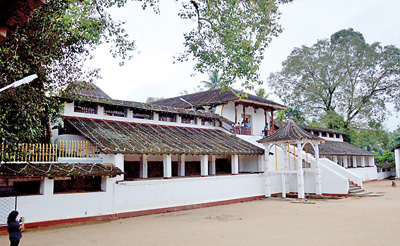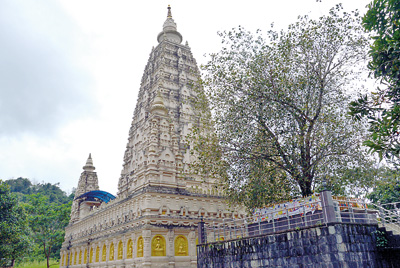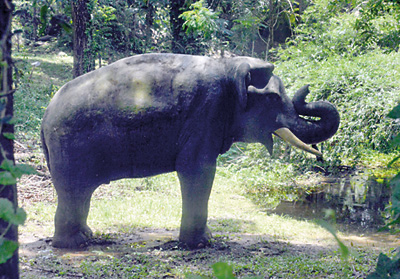Exploring the City of Gems
We all know that Ratnapura is world famous for the assortment of gemstones it produces and therefore attracts a number of visitors, both local and
foreign, to the location. Ever wondered what Ratnapura has to offer those visiting the place on leisure?
Wandering through the narrow streets bustling with early morning gem deals, Fun Travel took to exploring the City of Gems looking for the hidden attractions in the misty mountain range decorated with tea, rubber plantations, waterfalls and springs.
 National Museum in Ratnapura
National Museum in Ratnapura
The Museum displays an array of natural gems and mineral stones found in the area such as Garnets, Sapphires, Rubies, Topaz and Amethysts. Some of the main aspects in relation to the industry such as tools used for gem mining, a model depicting the mining process and a collection of photographs of the traditional gem mining methodology are also exhibited.
It is the Ehelepola Walawwa – the official residence of the Ehelepola Nilame who served as the Disawe (the local Governor) of Ratnapura that is converted to the Ratnapura Museum today capturing the proud cultural and natural heritage of the Ratnapura region.
The Museum displays traditional tools used by the inhabitants of Sabaragamuwa, musical instruments, jewellery, utensils used for food
consumption, traditional attire worn by the people as well as a palanquin (dolawa) found from a temple in the vicinity and many other artifacts. It has exhibition rooms
dedicated to wet zone insects, reptiles and medicinal plants common to the Sabaragamuwa Province.
Interestingly, a section of the Museum displays the fossilized remains of various animals such as a hippopotamus recovered from the gem pits in area.
The Palaeobiodiversity park found in the Museum garden represents the species believed to have existed in the area through life sized animal sculptures.
 Punchi Dambadiva
Punchi Dambadiva
(Mini Dambadiva)
The venue, situated along Ratgama along the Malwala Road hosts replicas of the sacred monuments found in the pilgrim site of Dambadiva
The Punchi Dambadiva complex building project which got underway in 1981, currently consists of a stunning replica of Buddhagayawa, Piriniwan Manchkaya
depicting the passing away of Buddha, located in Kusinarawa, a replica of the first dhamma sermon Buddha gave to his five disciples in Isipathanaramaya among many other interesting monuments.
Private Gem Museum
There is a private Gem Museum, along Pothgul Vihara Mawatha belonging to Purandara
Sri Badra Marapana, which can be inspected by appointment. The owner has started the Museum in the 70s, with the large collection of gems, stones and minerals that he has collected as a past time over a long period.
 St. Peter and Paul Cathedral in Main Street
St. Peter and Paul Cathedral in Main Street
This important shrine of Christian faith is about
135 years old. The Church had been built during the British period, by Rev. Fr. Romero Pornellio and its
beautifully crafted interior has many symbols that
represent the two saints. Two life size paintings on either side of the Cathedral depict Saint Peter being given a key by Jesus Christ and Saint Paul whom Jesus called the ‘sword’.
The roof is also embedded with key and sword symbols which are indicative of
reliability and power.
Saman Devalaya
This is considered the shrine of the deity who is regarded as the Guardian of Sabaragamuwa.
Saman Devalaya was built in 1226, by the Arya Kamadeva Maha Amathi of King Parakramabahu II, during the time the latter had his regime in Dambadeniya Kingdom. On the instructions of the king, the Arya Kamadeva had undertaken a visit to Sabaragamuwa for gem mining, to oblige the King’s request to fill
up the royal coffers that were drying up at that point.
 In Ratnapura, Arya Kamadeva found a statue of God Saman before which he made a vow for the success of his mission. As he was able to accomplish his task, Arya Kamadeva, out of much gratitude to the God Saman, put up a Devalaya at the location.
In Ratnapura, Arya Kamadeva found a statue of God Saman before which he made a vow for the success of his mission. As he was able to accomplish his task, Arya Kamadeva, out of much gratitude to the God Saman, put up a Devalaya at the location.
Design wise it is a unique piece of architecture; a wahalkada opening up to the lower platform and a flight of steps from the lower
platform taking you to the upper terrace where the main shrine of the Devalaya is located.
In the shrine you also come across a Portuguese period ‘gun’ which is
currently used to signal the starting of the annual Saman Devalaya perahera at the auspicious time.


